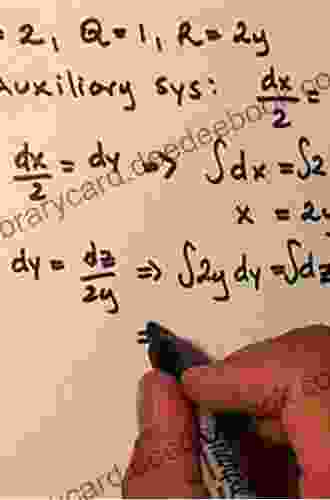Partial Differential Equations in Action: Unlocking the Hidden Patterns of Nature

<meta name="keywords" content="partial differential equations, mathematical equations, physical systems, fluid flow, heat diffusion, string vibrations, engineering, physics, economics, biology"> <p>Partial differential equations (PDEs) are mathematical equations that describe the behavior of continuous physical systems, such as the flow of fluids, the diffusion of heat, and the vibrations of strings. They are used in a wide variety of applications, from engineering and physics to economics and biology.</p> <p>PDEs are often difficult to solve, but they can be used to model a wide range of physical phenomena. For example, PDEs can be used to model the flow of water in a pipe, the spread of heat in a metal rod, and the vibrations of a guitar string.</p> <p>In this article, we will explore some of the most important PDEs and see how they are used to solve real-world problems. We will also discuss some of the challenges involved in solving PDEs and some of the techniques that are used to overcome these challenges.</p> <h2>The Diffusion Equation</h2> <p>The diffusion equation is a PDE that describes the flow of heat or mass in a continuous system. It is one of the most important PDEs and is used in a wide variety of applications, such as modeling the spread of heat in a metal rod, the diffusion of a chemical in a solution, and the flow of water in a pipe.</p> <p>The diffusion equation is given by the following equation:</p> $$\frac{\partial u}{\partial t}= \nabla \cdot (D \nabla u)$$ where: * $u$ is the concentration of the heat or mass * $t$ is time * $D$ is the diffusion coefficient The diffusion coefficient is a constant that depends on the material that the heat or mass is flowing through. The higher the diffusion coefficient, the faster the heat or mass will flow. The diffusion equation can be solved using a variety of methods, including analytical methods, numerical methods, and graphical methods. <h2>The Wave Equation</h2> <p>The wave equation is a PDE that describes the propagation of waves. It is used in a wide variety of applications, such as modeling the propagation of sound waves, the vibrations of strings, and the motion of water waves.</p> <p>The wave equation is given by the following equation:</p> $$\frac{\partial^2 u}{\partial t^2}= c^2 \nabla^2 u$$ where: * $u$ is the displacement of the wave * $t$ is time * $c$ is the wave speed The wave speed is a constant that depends on the material that the wave is propagating through. The higher the wave speed, the faster the wave will propagate. The wave equation can be solved using a variety of methods, including analytical methods, numerical methods, and graphical methods. <h2>The Laplace Equation</h2> <p>The Laplace equation is a PDE that describes the potential energy of a system. It is used in a wide variety of applications, such as modeling the electric potential around a charged particle, the pressure in a fluid, and the temperature in a solid.</p> <p>The Laplace equation is given by the following equation:</p> $$\nabla^2 u = 0$$ where: * $u$ is the potential energy The Laplace equation can be solved using a variety of methods, including analytical methods, numerical methods, and graphical methods. <h2>Challenges in Solving PDEs</h2> PDEs are often difficult to solve because they are nonlinear and have complex boundary conditions. Nonlinear PDEs are PDEs that contain nonlinear terms, such as products of unknown functions. Complex boundary conditions are boundary conditions that depend on the solution of the PDE. There are a number of challenges involved in solving PDEs, including: * **Finding a suitable solution method.** There are a variety of methods that can be used to solve PDEs, but each method has its own advantages and disadvantages. The best method for solving a particular PDE will depend on the specific equation and the boundary conditions. * **Dealing with nonlinearity.** Nonlinear PDEs are more difficult to solve than linear PDEs. This is because nonlinear PDEs can exhibit a variety of complex behaviors, such as chaos and turbulence. * **Handling complex boundary conditions.** Complex boundary conditions can make it difficult to solve PDEs. This is because the boundary conditions can affect the solution of the PDE in a nonlinear way. <h2>Techniques for Solving PDEs</h2> There are a number of techniques that can be used to solve PDEs, including: * **Analytical methods.** Analytical methods are methods that use mathematical techniques to find exact solutions to PDEs. Analytical methods can be used to solve a wide variety of PDEs, but they are often difficult to apply to complex PDEs. * **Numerical methods.** Numerical methods are methods that use computers to approximate solutions to PDEs. Numerical methods can be used to solve a wide variety of PDEs, including nonlinear PDEs and PDEs with complex boundary conditions. * **Graphical methods.** Graphical methods are methods that use graphs to visualize the solutions of PDEs. Graphical methods can be used to gain a qualitative understanding of the behavior of PDEs. <h2>Applications of PDEs</h2> PDEs are used in a wide variety of applications, including: * **Engineering:** PDEs are used to model a wide range of engineering problems, such as the flow of fluids, the diffusion of heat, and the vibrations of structures. * **Physics:** PDEs are used to model a wide range of physical phenomena, such as the propagation of waves, the motion of particles, and the behavior of fluids. * **Economics:** PDEs are used to model a wide range of economic problems, such as the flow of money, the diffusion of information, and the behavior of markets. * **Biology:** Partial differential equations are used to model a wide range of biological phenomena, such as the growth of cells, the spread of diseases, and the behavior of ecosystems. PDEs are a powerful tool for modeling a wide range of physical phenomena. They are used in a variety of applications, from engineering and physics to economics and biology. Partial differential equations are a powerful tool for modeling a wide range of physical phenomena. They are used in a variety of applications, from engineering and physics to economics and biology. In this article, we have explored some of the most important PDEs and seen how they are used to solve real-world problems. We have also discussed some of the challenges involved in solving PDEs and some of the techniques that are used to overcome these challenges. PDEs are a complex and challenging subject, but they are also a fascinating and rewarding one. If you are interested in learning more about PDEs, I encourage you to explore the resources that are available online and in libraries.4.2 out of 5
| Language | : | English |
| File size | : | 17754 KB |
| Screen Reader | : | Supported |
| Print length | : | 704 pages |
Do you want to contribute by writing guest posts on this blog?
Please contact us and send us a resume of previous articles that you have written.
 Page
Page Text
Text Reader
Reader Library
Library Paperback
Paperback E-book
E-book Sentence
Sentence Bibliography
Bibliography Preface
Preface Annotation
Annotation Scroll
Scroll Codex
Codex Tome
Tome Bestseller
Bestseller Library card
Library card Biography
Biography Autobiography
Autobiography Memoir
Memoir Dictionary
Dictionary Thesaurus
Thesaurus Narrator
Narrator Character
Character Resolution
Resolution Librarian
Librarian Borrowing
Borrowing Stacks
Stacks Archives
Archives Periodicals
Periodicals Study
Study Research
Research Scholarly
Scholarly Journals
Journals Reading Room
Reading Room Special Collections
Special Collections Interlibrary
Interlibrary Literacy
Literacy Dissertation
Dissertation Storytelling
Storytelling Awards
Awards Reading List
Reading List Scott Joplin
Scott Joplin Reinhold Seitl
Reinhold Seitl Daisaku Ikeda
Daisaku Ikeda Rik Thistle
Rik Thistle Michael Weinreb
Michael Weinreb Jean Pierre Perrin
Jean Pierre Perrin Paula Friedrichsen
Paula Friedrichsen Paul A Djupe
Paul A Djupe Michel Zohar Ben Dor
Michel Zohar Ben Dor Margaret J Anderson
Margaret J Anderson Jack Steen
Jack Steen Tina Pisco
Tina Pisco Mike Lupica
Mike Lupica Lynda Bulla
Lynda Bulla Merrily Home
Merrily Home Dennic Chunman Lo
Dennic Chunman Lo Bonnie S Calhoun
Bonnie S Calhoun Paul Kelly
Paul Kelly Saransh Paliwal
Saransh Paliwal Lisa Kerpoe
Lisa Kerpoe
Light bulbAdvertise smarter! Our strategic ad space ensures maximum exposure. Reserve your spot today!

 Leo MitchellThe Handbook of Financial Modeling: A Comprehensive Guide to Best Practices...
Leo MitchellThe Handbook of Financial Modeling: A Comprehensive Guide to Best Practices... Harold BlairFollow ·4k
Harold BlairFollow ·4k Chase MorrisFollow ·17.7k
Chase MorrisFollow ·17.7k Isaac MitchellFollow ·16.4k
Isaac MitchellFollow ·16.4k Gabriel BlairFollow ·7.3k
Gabriel BlairFollow ·7.3k Brody PowellFollow ·19.4k
Brody PowellFollow ·19.4k Henry Wadsworth LongfellowFollow ·5.8k
Henry Wadsworth LongfellowFollow ·5.8k Felix HayesFollow ·4k
Felix HayesFollow ·4k Christian BarnesFollow ·2.4k
Christian BarnesFollow ·2.4k

 Braden Ward
Braden WardPopular Classical Carols of All Time for Beginner Trumpet...
Christmas is a time...

 Galen Powell
Galen PowellDark Secrets Unraveled: Exploring the Enigmatic Dark 15
In the depths of the...

 Michael Chabon
Michael ChabonDino Mike and the Living Fossils: Unlocking the Secrets...
In a world teeming...

 Henry Green
Henry GreenThe Enchanting World of Jeevan: A Journey Through the...
In the realm of children's...

 Kirk Hayes
Kirk HayesWho Did It First: A Comprehensive History of Human...
Innovation is the...
4.2 out of 5
| Language | : | English |
| File size | : | 17754 KB |
| Screen Reader | : | Supported |
| Print length | : | 704 pages |












